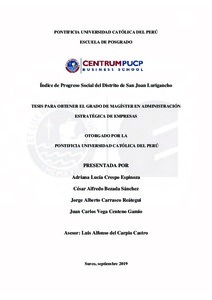| dc.contributor.advisor | D’Alessio Ipinza, Fernando Antonio | |
| dc.contributor.author | Crespo Espinoza, Adriana Lucía | |
| dc.contributor.author | Bezada Sánchez, César Alfredo | |
| dc.contributor.author | Carrasco Reátegui, Jorge Alberto | |
| dc.contributor.author | Vega Centeno Gamio, Juan Carlos | |
| dc.date.accessioned | 2019-12-11T21:25:55Z | |
| dc.date.available | 2019-12-11T21:25:55Z | |
| dc.date.created | 2019-09 | |
| dc.date.issued | 2019-12-11 | |
| dc.identifier.uri | http://hdl.handle.net/20.500.12404/15526 | |
| dc.description.abstract | San Juan de Lurigancho es uno de los distritos más representativos del Perú, no solo
por ser el más poblado del país, sino por ser producto de la convergencia de una gran
diversidad de idiosincrasias y procedencias, surgidas a raíz de los procesos migratorios desde
inicios de la colonia hasta la explosión demográfica en la segunda mitad del siglo XX. Es en
este contexto que el Índice de Progreso Social (IPS) es de vital importancia pues ayuda a
caracterizar y develar la calidad de vida de los más de un millón de personas que habitan el
distrito, más allá de indicadores estrictamente económicos; permitiendo identificar las brechas
de progreso social, en términos de necesidades humanas básicas, fundamentos de bienestar y
oportunidades para todos los ciudadanos. En consecuencia, la presente investigación tuvo
como propósito calcular el modelo del IPS del distrito de San Juan de Lurigancho, partiendo
de su división en cuatro zonas geográficas y recolectando información tanto de fuentes
primarias como secundarias; con el fin de establecer el nivel de progreso social de cada una
de ellas, teniendo en cuenta las dimensiones, componentes e indicadores establecidos por la
metodología.
Así pues el distrito de San Juan de Lurigancho alcanzó un IPS de 53.40, que lo
situaron en la categoría baja; a nivel de dimensiones, tanto fundamentos de bienestar como
oportunidades se ubicaron en la categoría baja; y a nivel de componentes las mayores
oportunidades de mejora se mostraron en: seguridad personal, sostenibilidad ambiental y el
acceso a la educación superior; además se estableció que las zonas más críticas son la tres y
cuatro con un nivel de progreso social muy bajo y bajo, respectivamente. Estos resultados
mostraron una realidad que requiere de atención inmediata por parte de las autoridades y
actores sociales involucrados; para ello, se formularon recomendaciones que tienen como
finalidad actuar como fuente para implementar las iniciativas necesarias a través de las
entidades competentes, que permitan potenciar la merecida calidad de vida de sus habitantes. | es_ES |
| dc.description.abstract | San Juan de Lurigancho is one of the most representative districts of Peru, not only
because it is the most populous in the country but also it is the product of the convergence of
a great diversity of idiosyncrasies and provenances, arisen as a result of the migratory
processes since the beginning of the colony until the demographic explosion in the second
half of the twentieth century. Into this context, the Social Progress Index (SPI) is of vital
importance as it helps to characterize and reveal the quality of life, of more than one million
people that live in the district, beyond strictly economic indicators, allowing identify the gaps
in social progress in terms of basic human needs, foundations of wellbeing and opportunities
for all citizens. Consequently, the present investigation aims to calculate the model of SPI of
the district of San Juan de Lurigancho, starting by its division into four geographical zones
and collecting information from primary and secondary sources in order to establish the level
of social progress in each of them, taking into account the dimensions, components and
indicators stablished by the methodology.
In that way, the district of San Juan de Lurigancho got a SPI of 53.40, locating it in the
low level of the scale; at the level of dimensions, both foundations of wellbeing and
opportunities located in the low category; and at the component level the mayor improvement
opportunities are into: personal safety, environmental quality and access to advanced
education; additionally it was stablished that the most critical zones are the three and four,
with a very low and low level of social progress, respectively. These results showed a reality
that requires immediate attention from the authorities and social actors involved; in that way,
recommendations were formulated which are intended to act as a source for implementing the
necessary initiatives through the competent entities that allows potentiate the deserved quality
of life of its inhabitants. | es_ES |
| dc.language.iso | spa | es_ES |
| dc.publisher | Pontificia Universidad Católica del Perú | es_ES |
| dc.rights | info:eu-repo/semantics/openAccess | es_ES |
| dc.rights.uri | http://creativecommons.org/licenses/by-nc-nd/2.5/pe/ | * |
| dc.subject | Indicadores sociales--Perú--San Juan de Lurigancho (Lima : Distrito) | es_ES |
| dc.subject | Indicadores económicos--Perú--San Juan de Lurigancho (Lima : Distrito) | es_ES |
| dc.subject | Investigación cuantitativa | es_ES |
| dc.title | Índice de progreso social del distrito de San Juan Lurigancho | es_ES |
| dc.type | info:eu-repo/semantics/masterThesis | es_ES |
| thesis.degree.name | Maestro en Administración Estratégica de Empresas | es_ES |
| thesis.degree.level | Maestría | es_ES |
| thesis.degree.grantor | Pontificia Universidad Católica del Perú. CENTRUM | es_ES |
| thesis.degree.discipline | Administración Estratégica de Empresas | es_ES |
| renati.advisor.dni | 41319855 | |
| renati.advisor.orcid | https://orcid.org/0000-0002-4242-1220 | es_ES |
| renati.author.dni | 46423031 | |
| renati.author.dni | 46652180 | |
| renati.author.dni | 43859476 | |
| renati.author.dni | 23998645 | |
| renati.discipline | 413307 | es_ES |
| renati.level | https://purl.org/pe-repo/renati/level#maestro | es_ES |
| renati.type | https://purl.org/pe-repo/renati/type#tesis | es_ES |
| dc.publisher.country | PE | es_ES |
| dc.subject.ocde | https://purl.org/pe-repo/ocde/ford#5.02.04 | es_ES |






